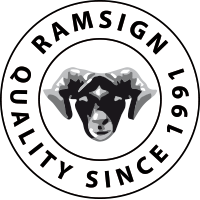This is an article that was originally written in Danish by the journalist Allan Mylius Thomsen. It was first published on the 3rd January 1996. We have translated it into English for your enjoyment.

(Original title: Når man skilter med sin uvidenhed)
When you flaunt your ignorance
At Copenhagen City Hall some people are, politely speaking, trying to mess with the city's graffiti artists. Whether this is because these municipal officials totally lack historical understanding, professional insight, or are just stupid and clumsy, I do not know. But nonetheless, they have begun to desecrate the streets of Copenhagen with a masterpiece of disobedience and scriptural incomprehension. They even get paid for their actions, unlike their colleagues with the spray bottles, who get punished if they get caught.
Copenhagen Street Signs
These are Copenhagen's new plastic street signs. This useful material should not in itself be scolded. It is probably both cheaper and more practical to produce plastic street signs than the old-fashioned method of vitreous enamelled or cast metal signs. But to replace the lettering on the signs with a design disaster without blinking an eye, and without giving any reasonable explanation, is another matter.
I certainly notice it. Both because I care about my city's history, but also because I originally trained as an advertising designer, and learned to paint letters with a sign painter's brush and cane. This has given me a fair insight into the history of typography, and into something referred to by professionals as “script aesthetics”. Municipal officials should have had a crash course in that before they started mistreating our city's street signs.
The fact that streets have an official name is actually quite recent, as is the consecutive numbering of doors and gates.

The Rule of Naming
Before that time, a house was referred to by its owner's name. Later, they were given a land number. In many places in the medieval town, you can still see this number carved into the end stone of the gate, in a beautiful old antique script. Consecutive house numbers were only introduced after 1859, with even and odd numbers on either side. They were introduced by Krak, the town conductor, the one with the road signs. The street names also came from the people. As the city gradually grew in number, the citizens themselves gave streets and alleys nicknames to help them find their way around. Many of these names still survive, such as Larsbjørnsstræde. Around 1460, a man named Laurids Bjørnson took over two plots in the street. The street therefore became Larsbjørnsstræde, as it is known to this day.
King Christian the 4th's Plan
But it was only when King Christian the 4th built Nyboder in 1631-41 that people began to putofficial names to the streets. They were painted on the houses in the most beautiful Roman antiqua. It is known from the inscriptions on the famous 39-metre-high Trajan Column in Rome from around 114 AD. The inscription was first painted with a brush and then carved with a chisel, a technique that suits the pointed brushstrokes. These capital letters are the archetype of all Western European writing. Generally speaking, antiqua letters all have feet and hats on the vertical strokes.

The Arrival of New Signage
It was a good custom Copenhagen founded, and many designs of street signs have been seen since. There have been painted directly on the walls, on wooden plates, then came the blue and white vitreous enamel signs and then the cast ones, but always with antiqua typefaces. They were well suited to the old houses and crooked streets and alleys of the medieval town.
At the turn of 1996 Copenhagen became the European Capital of Culture. On that occasion, someone at City Hall figured out that the city needs new and uniform street signs. Some crook must have whispered to a city official that in the nearby Gentofte Municipality they had some highly praised street signs designed by Professor Engelhardt in the 1920s. "Such a marvel we must also have", the good official apparently thought. With a plagiarism ability that should have made our Minister of Culture come running with the law on copyright and especially the paragraph on droit morale (the artistic protection), new street signs were now produced for Copenhagen.

Engelhardt and the Gentofte Municipality
Unfortunately, our Minister for Culture was able to declare on taking office that she did not see it that way. That is probably why this pitiful imitation has not been denounced by proper authority. Professor Engelhardt was a skilled designer. When Gentofte Municipality asked him to name their streets and roads, he drew inspiration from the most modern writing of the day. Around the First World War, the Englishman Edward Johnston designed a good modernisation of the original early 19th century grotesque font for the London Underground. Grotesques are those without feet and hats on the vertical lines. Johnston's writing was in many ways a guide for later grotesque sketches.
Engelhardt's Designs
Engelhardt creatively transformed this script into Gentofe's street signs, with the characteristic little heart as the dot above every letter that had one, as a play on the ending of his name. The spacing between the letters was carefully created so that legibility was not lost. It looked very nice in the new modern community surroundings.
Unfortunately, Copenhagen officials do not possess the same craftsmanship, skill and background knowledge as did Engelhardt. The letters on the new plastic street signs shout at each other as if they were thrown up with a mallet.

Heritage Meets Modern
The officials' sense of history can be given a question. In any case, I get a dull taste in my mouth when a protected building from 1728 now has a plastic sign with a typeface that has its roots in the 1920s. Often houses like that with public preservation orders have cost fortunes to bring back to their original appearance. Such details don't seem to bother the officials who preside over something as distinctive as the city's street signs.
Numerous are the homeowners who have protested the typography rape. But the Copenhagen municipality once again knows better. I wonder where they get all that better knowledge from. Certainly not from the history books.

